
Thomas Hobbes and the Iconography of the Leviathan State
Introduction
In a recent post on the cover art of the French thinker Étienne de la Boétie I remarked about one cover that:
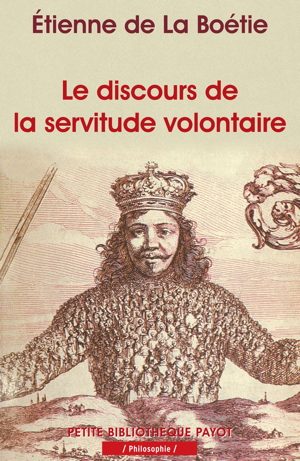
This edition by Payot (2016) shows the classic illustration from Thomas Hobbes’ book Leviathan (1652). The “leviathan” monarch’s body is composed of thousands of small figures of his subjects. If the individuals which made up the Leviathan’s body decided to walk away or do something else, then the “body politic” would collapse and the Leviathan would then no longer exist.
This got me thinking about the meaning of Hobbes’s frontispiece as a piece of political iconography, which is a topic I have been exploring for a couple of decades in my collection of “illustrated essays” on “Images of Liberty and Power”. There has been some interesting recent research on the imagery used by Hobbes in his political writings and I am glad to see the historical profession catching up with me. See for example Horst Bredekamp, Thomas Hobbes Visuelle Strategien (1999, 2007, 2012) and Justin Champion, “Decoding the Leviathan: Doing the History of Ideas through Images, 1651–1714” (2010)). In analysing Hobbes’ imagery there are a number of perspectives one could take:
- what was meant in the original story in The Book of Job (which he quotes at the top of the frontispiece) where the arrogant and authoritarian Christian God boasts to the persecuted and hapless Job about the complex and magnificent things he alone had the power and the will to create, including “Behemoth” (a land-dwelling “beast” or “monster” which was unspecified in the Book but interpreted by later readers as being a hippopotamus, of all things) and “Leviathan” (a water-dwelling creature or “sea monster” which was also unspecified but later interpreted to be a whale or a crocodile, neither of which was a fish)
- the visual and verbal depiction of “Leviathan” (and to a lesser extent “Behemoth”) in Hobbes’ writings and how he adapted biblical and contemporary understanding of these creatures to suit his own political and theoretical purposes, and
- its relationship to the other frontispieces Hobbes used (and partly designed himself) for his other writings, and their political meaning
- and finally some visual alternatives to a “Leviathan” state - why not have the protector of our lives and liberties a “Colossus” (as envisaged by Goya to defend Spain from Napoleon), or a Renaissance Humanist “Gargantua” (as envisaged by Rabelais)? I would like to write another post contrasting the two most common words used to describe large creatures, gargantuan and leviathan, and the very different political connotations they have.
 |
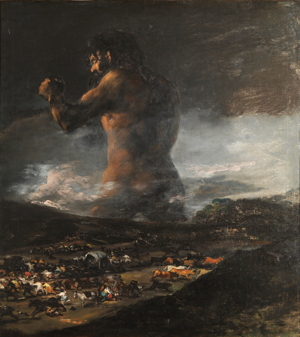 |
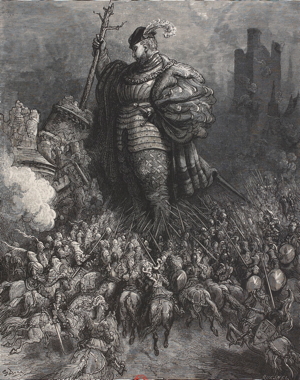 |
Leviathan and Behemoth in the Book of Job
Some people regard The Book of Job as a profound reflection on human suffering, the inexplicable nature of human suffering, and the need to have courage in the face of that suffering. I, on the other hand, saw it as persuasive reason for not accepting the existence of a Christian god who would violate the rights and liberties of an innocent man and his family at will (even capriciously), and, if such a ghastly god did exist, then individuals who valued life, liberty and property should resist the actions of such a god (or “his” mortal representatives and advocates on earth), even taking up arms to overthrow him and bring him to justice for his crimes against humanity.
In one of several “speeches” god gave to Job (from within a whirlwind of all things!) he attempts to intimidate Job and put him back into his subservient position, by reminding him of all the “wonders” of creation which he alone had the foresight and ability to bring into existence. He does this in a kind of visual demonstration of his power by pointing to some of the most notable things (in his view) of his creation (why ostriches?). Some of these “wonders” are very strange and would seem to only impress an ignorant, gullible, and pre-scientific superstitious people such as the Hebrew people. It is in the course of this recitation of god’s bio-engineering CV that there is reference to the monsters of the land and the sea, Behemoth and Leviathan. God boasts that he
- created the land and the sea (which was “shut up” by doors) (38:4)
- snow and hail (38:28)
- and then a long list of familiar animals such as lions, ravens, goats, asses, ostriches, horses, hawks, and eagles
- as well as several imaginary beasts which do not and have never existed such as unicorns (39:9); and importantly in this context “Behemoth” (40: 15) and his bizarre description of it including its well-endowed sexual organs (40: 15-24); followed by “Leviathan” (41:1- 34) and a long description of this imaginary beast, which includes the passage quoted on the frontispiece of Hobbes’ book: “41:33. Upon earth there is not his like (who is made without fear).” One might ask - “fear of what?”
These strange descriptions provided by god deserve to be quoted in full. The first is the King James Version, the second is the modern translation by Robert Alter. The sexual prowess of the Behemoth is coyly referred to by the King James Version translators (“tail” and “stones”) but is revealed more clearly in Robert Alter’s modern translation.
On the land monster Behemoth (Job 40:15-24):
15. Behold now behemoth, which I made with thee; he eateth grass as an ox. 16. Lo now, his strength is in his loins, and his force is in the navel of his belly. 17. He moveth his tail like a cedar: the sinews of his stones are wrapped together. 18. His bones are as strong pieces of brass; his bones are like bars of iron. 19. He is the chief of the ways of God: he that made him can make his sword to approach unto him. 20. Surely the mountains bring him forth food, where all the beasts of the field play. 21. He lieth under the shady trees, in the covert of the reed, and fens. 22. The shady trees cover him with their shadow; the willows of the brook compass him about. 23. Behold, he drinketh up a river, and hasteth not: he trusteth that he can draw up Jordan into his mouth. 24. He taketh it with his eyes: his nose pierceth through snares. |
40: 15. Look, pray: Behemoth, whom I made with you, 16. Look, pray: the power in his loins, 17. He makes his tail stand like a cedar, 18. His bones are bars of bronze, 19. He is the first of the ways of God. 20. For the mountains offer their yield to him, 21. Underneath the lotus he lies, 22. The lotus hedges him, shades him, 23. Look, he swallows a river at his ease, 24. Could one take him with one’s eyes,” |
On the sea monster Leviathan (Job: 41):
1. Canst thou draw out leviathan with an hook? or his tongue with a cord which thou lettest down? 2. Canst thou put an hook into his nose? or bore his jaw through with a thorn? 3. Will he make many supplications unto thee? will he speak soft words unto thee? 4. Will he make a covenant with thee? wilt thou take him for a servant for ever? 5. Wilt thou play with him as with a bird? or wilt thou bind him for thy maidens? 6. Shall the companions make a banquet of him? shall they part him among the merchants? 7. Canst thou fill his skin with barbed irons? or his head with fish spears? 8. Lay thine hand upon him, remember the battle, do no more. 9. Behold, the hope of him is in vain: shall not one be cast down even at the sight of him? 10. None is so fierce that dare stir him up: who then is able to stand before me? 11. Who hath prevented me, that I should repay him? whatsoever is under the whole heaven is mine. 12. I will not conceal his parts, nor his power, nor his comely proportion. 13. Who can discover the face of his garment? or who can come to him with his double bridle? 14. Who can open the doors of his face? his teeth are terrible round about. 15. His scales are his pride, shut up together as with a close seal. 16. One is so near to another, that no air can come between them. 17. They are joined one to another, they stick together, that they cannot be sundered. 18. By his neesings a light doth shine, and his eyes are like the eyelids of the morning. 19. Out of his mouth go burning lamps, and sparks of fire leap out. 20. Out of his nostrils goeth smoke, as out of a seething pot or caldron. 21. His breath kindleth coals, and a flame goeth out of his mouth. 22. In his neck remaineth strength, and sorrow is turned into joy before him. 23. The flakes of his flesh are joined together: they are firm in themselves; they cannot be moved. 24. His heart is as firm as a stone; yea, as hard as a piece of the nether millstone. 25. When he raiseth up himself, the mighty are afraid: by reason of breakings they purify themselves. 26. The sword of him that layeth at him cannot hold: the spear, the dart, nor the habergeon. 27. He esteemeth iron as straw, and brass as rotten wood. 28. The arrow cannot make him flee: slingstones are turned with him into stubble. 29. Darts are counted as stubble: he laugheth at the shaking of a spear. 30. Sharp stones are under him: he spreadeth sharp pointed things upon the mire. 31. He maketh the deep to boil like a pot: he maketh the sea like a pot of ointment. 32. He maketh a path to shine after him; one would think the deep to be hoary. 33. Upon earth there is not his like, who is made without fear. 34. He beholdeth all high things: he is a king over all the children of pride. |
40: 25. Could you draw Leviathan with a hook, 26. Could you put a lead line in his nose, 27. Would he urgently entreat you, 28. Would he seal a pact with you, 29. Could you play with him like a bird, 30. Could hucksters haggle over him, 31. Could you fill his skin with darts, 32. Just put your hand upon him— 41: 1. Look, all hope of him is dashed, 2. No fierce one could arouse him, 3. Who could go before Me in this I’d reward, 4. I would not keep silent about him, 5. Who can uncover his outer garb, 6. Who can pry open the doors of his face? 7. His back is rows of shields, 8. Each touches against the next, 9. Each sticks fast to the next, 10. His sneezes shoot out light, 11. Firebrands leap from his mouth, sparks of fire fly into the air.” 12. From his nostrils smoke comes out, 13. His breath kindles coals, 14. Strength abides in his neck, 15. The folds of his flesh cling together; 16. His heart is cast hard as stone, 17. When he rears up, the gods are frightened, 18. Who overtakes him with sword, it will not avail, 19. Iron he deems as straw, 20. No arrow can make him flee, 21. Missiles are deemed as straw, 22. Beneath him, jagged shards, 23. He makes the deep boil like a pot, 24. Behind him glistens a wake, 25. He has no match on earth, 26. All that is lofty he can see. |
Hobbes would quote Job 41:33 “Upon earth there is not his like” on the frontispiece to his book Leviathan (1651) and refer to it again in Part II. Of Common-Wealth. Chap. XXVII. Of Punishments, And Rewards:
Hitherto I have set forth the nature of Man, (whose Pride and other Passions have compelled him to submit himselfe to Government;) together with the great power of his Governour, whom I compared to Leviathan, taking that comparison out of the two last verses of the one and fortieth of Job; where God having set forth the great power of Leviathan, calleth him King of the Proud. There is nothing, saith he, on earth, to be compared with him. He is made so as not to be afraid. Hee seeth every high thing below him; and is King of all the children of pride. But because he is mortall, and subject to decay, as all other Earthly creatures are; and because there is that in heaven, (though not on earth) that he should stand in fear of, and whose Lawes he ought to obey; I shall in the next following Chapters speak of his Diseases, and the causes of his Mortality; and of what Lawes of Nature he is bound to obey.
It is hard to know what Hobbes really thought about these mythical creatures (fire-breathing sea monsters whose scales were impervious to human weapons), whether he was as ignorant of science and gullible as most people of his time were, or whether some scientific scepticism might have entered his mind (he was interested in the science of optics). Perhaps he was sceptical but found the idea of terrifying ordinary people with allusions to these stories was useful to his political purpose of cementing the legitimacy of the power of an absolutist monarch/tyrant/sovereign. Or perhaps he was just playing games with his readers.
It should be noted that there is another important reference to Leviathan in one of the Psalms (104: 24-31) which tells us that god likes to play with his pet Leviathans, perhaps after a hard day running the universe, he likes to relax in the evenings by playing with them like a mortal man would do with his dog, calling them to gather around him and then feeding them by hand which makes them happy, or punishing them for who knows what by refusing to look at them, or even killing them and then bringing more of them into existence (perhaps also for sport):
24. O Lord, how manifold are thy works! in wisdom hast thou made them all: the earth is full of thy riches. 25. So is this great and wide sea, wherein are things creeping innumerable, both small and great beasts. 26. There go the ships: there is that leviathan, whom thou hast made to play therein. 27. These wait all upon thee; that thou mayest give them their meat in due season. 28. That thou givest them they gather: thou openest thine hand, they are filled with good. 29. Thou hidest thy face, they are troubled: thou takest away their breath, they die, and return to their dust. 30. Thou sendest forth thy spirit, they are created: and thou renewest the face of the earth. |
24. How many Your deeds, O LORD, 25. This sea great and wide, 26. There the ships go, 27. All of them look to You 28. When You give them, they gather it in, 29. When You hide Your face, they panic, 30. When You send forth Your breath, they are created, |
Patricia Springborg has argued that Hobbes also might have been trying to be deliberately provocative (demonstrating his “sheer perversity”, p. 361) by using Job’s description of Behemoth and Leviathan in an allegorical way to criticise the power of the Papacy as a competitor to what should be the sole and unique power of the state in England. No earthly power, whether it be Egypt, Assyria, or Rome could hope to “hook” and thereby kill or tame Leviathan, and neither could the Papacy “hook” or subdue the Protestant Common-Wealth. As Hobbes mockingly said in his long poem Historia Ecclesiastica (History of the Church) (1688), pp. 455-65:
Even the Patriarch of Constantinople yielded, if tardily, although he was equally deserving of honour.
Leviathan, like Behemoth, had again taken the hook in the nose; both the king and the people were slaves.
Sec. So nothing further remained for the Pope to do but bless humankind with his own light,
And, after the kingdom on earth, seek the kingdom of heaven, as wily as a snake, but with the simplicity of a child.
Pr. ‘The father granted him one prayer and denied him the other’. Without doubt the first was granted, the latter not at all.
The popes by their own cunning overcame all the monsters that the earth produces.
But the double realm, bodily and spiritual, was not a mark of excessive simplicity.
You cannot believe that the Popes spent their lives in leisure, and do not think that they had nothing further to do.
The desires of men are always increased by desires fulfilled. Increasing affluence protects wealth already acquired.
The shrewd fisherman does not neglect his customary skill, however great the prey entangled in his nets.
He always pursues his own advantage. Whether he is mending his nets if at some point a great whale has forced its way through,
Or perhaps thinking about hooks and new bait for fish, or seeking to attach some tricky device,
Or offer them colours of bait that they like, or poisons to pollute clear waters.
And having sent out his servants, he examines every shoreline to find which certain fish flee and which ones they love.
Then his next concern is what he can sell, to whom and for how much; and what fish to keep for his own table.
Which fish he should sprinkle with salt; and which he should preserve with a large quantity of salt; and which fish is rotten and should be thrown away.
To these many concerns, add this, the greatest, to build enduring houses for his children.
Similar concerns surround the Pope, and his skill is similar; he too always pursues his own advantage.
And for princes he prepares new chains of religion, delicate, but which their stupidity will make strong.
If necessity demands, he mends his nets with new teachings or lightens the burden of religious belief,
Or embellishes some monstrosity of a doctrine from Circe’s box, in such a way that Pythian Apollo might believe it was his own.
Otherwise he holds up some absurd dogma with two prongs, by which a once clever man, stupefied, is ensnared,
And he is bound to send to remote peoples, to enquire who they may be, and the sort of bait that pleases them.
But it should be kept in mind that historically the Leviathan was seen as an agent of the devil, as a threat to the life and safety of ordinary human beings and not as their defender. This image by Lambert of St Omer of the Antichrist seated on the Leviathan (Liber Floridus, 1120) is typical of this traditional perspective:
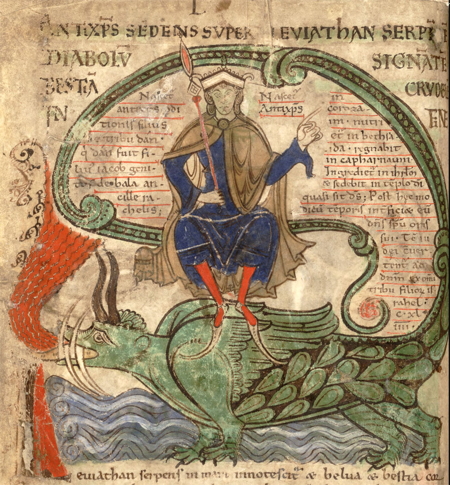
The abject terror which these real and imaginary monsters instilled in ancient and medieval people is hard to understand today. As late as the late eighteenth century wolves in European forests were still a major threat to life and limb and were justifiably feared and avoided. The fear of monsters like Leviathan in the biblical world has been explored by Gert Kwakkel and Nicholas Ansell in Playing with Leviathan: Interpretation and Reception of Monsters from the Biblical World (2017) and also by Patricia Springborg in “Hobbes’s Biblical Beasts: Leviathan and Behemoth” (1995). Depicting maritime monsters was a staple for medieval and early modern cartographers who sprinkled images of fanciful creatures on the periphery of their maps to warn unwary seafarers of potential danger. (See the richly illustrated review by “P.K.” of Chet Van Duzer, Sea Monsters on Medieval and Renaissance Maps (2013) for a striking array of fearsome looking creatures, as well as his own collection of “Map Monsters” taken from from Aldrovandi’s History of Monsters.) I include one of these below because of the similarity to Hobbes’s depiction of Leviathan as well as a famous 1956 movie:
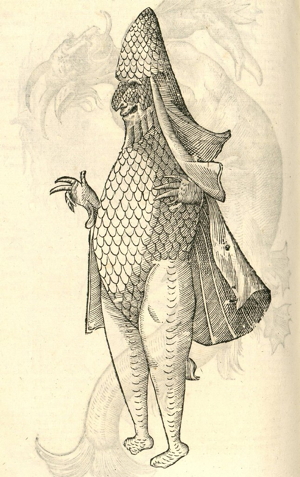
Monstrum Marinum rudimenta habitus Episcopi referens
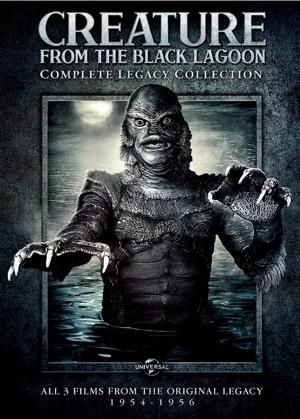
Given this widespread fear of sea-creatures which had existed for centuries, the more benign interpretation of Leviathan as a “protector” was an invention of Hobbes which needs to be explained.
Hobbes did not do the same for Behemoth as he had done for Leviathan, i.e. in designing a complex frontispiece for one of his books. His book on the history of the Civil War and revolution in England was entitled Behemoth: the history of the causes of the civil wars of England, and of the counsels and artifices by which they were carried on from the year 1640 to the year 1660 and only published posthumously in 1681 (but written in 1668). It is interesting to speculate on what form this frontispiece might have looked like.
The most famous depiction of the pair of biblical beasts was done by William Blake (1757–1827) for his illustrated edition of The Book of Job (1806, 1821, 1826). I put an edition of this online many years ago.

Blake’s depiction of Behemoth looks to me like a toothy megafauna wombat, and Leviathan like a fire-breathing legless water snake.
The Frontispiece to Hobbes’ book
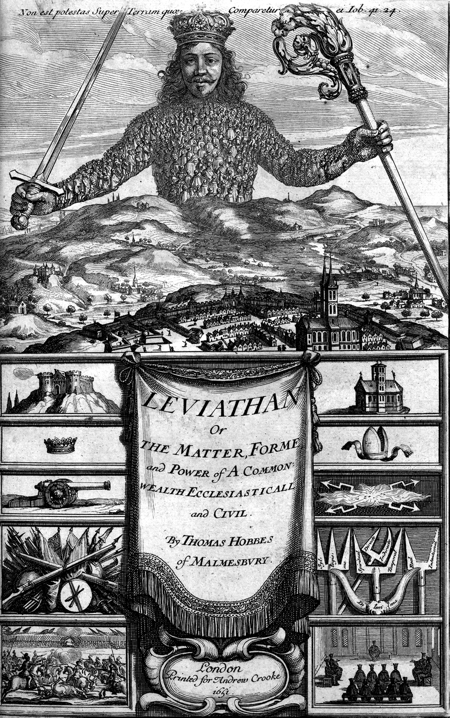
Overview
The standard interpretation of the frontispiece is that the sole, all-powerful sovereign, Leviathan, stands above his domain, surveying it with the two symbols of his power in his hands; in his right hand the sword of military might and coercion, and in his left hand, a bishop’s crozier symbolising the power of the church and the ideological control this gives him over “his” people. Below each outstretched arm there is a panel of images (each with its counterpart on the other side) which provide more detail about the means of control which each of these two means of power gives him. There is the castle / church; the crown / bishop’s mitre; a cannon / the lightning bolts of excommunication; guns and flags and drums for military battle / the weapons of argument and disputation for theological/ideological battle; armed forces confronting each other on the battle field / the court of the Inquisition where heretics confront the upholders of orthodoxy. Concerning the weapons of theological battle the following named weapons are shown: at the bottom, the "horns of a "dilemma"; on the right the barbs of what is "Real" and "Intentional"; at the middle front the difference between the "Spiritual" and the "Temporal"; at the middle rear two different ways of arguing, the "Directe" or the "Indirecte"; and at the left the "Syllogisme."
A closer inspection of the detail, sometimes hidden within the image, reveals some other interesting and intriguing possibilities for interpretation.
Leviathan is really a Giant Man-Fish
In their 2014 article Magnus Kristiansson and Johan Tralau, “Hobbes’s hidden monster: A new interpretation of the frontispiece of Leviathan,” 2014) argue that Leviathan really is a giant Man-Fish who/which has risen out of the sea and is “standing” behind the hill on which the town is situated, thus we can’t see his tail or fins clearly. They believe that we can see the tips of his/its tail poking up and barely visible under his right arm and left elbow, but only when we view a high resolution picture of the frontispiece.
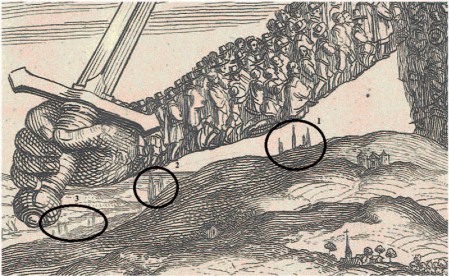
They provide a number of pictures of such Fish-Men to support their argument:
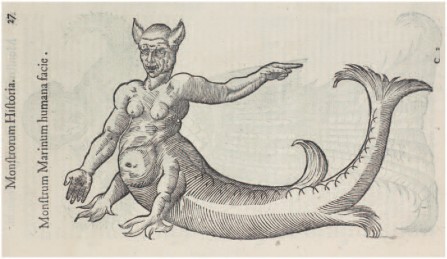
[Ulisse Aldrovandi: Monstrorum historia, 1642.]
Others have either ignored the “fins” poking up over the edge of the hill, or argued they are the tips of trees (pine trees?) or the spires of churches or the tops of buildings.
Kristiansson and Tralau also argue, less plausibly, that the hundreds of images of people within Leviathan’s body look like the “scales” of a fish.
In addition, they argue that we can see signs of a naval battle in the background (a cannon shot from the castle, ships in the sea behind Leviathan) which suggest an invasion of the land from the sea is taking place (they suggest something inspired by the failed invasion by the Spanish Armada in 1588 which traumatised Hobbes’ family (he was born in 1588)). They suggest Leviathan has come to rescue the English people from foreign invasion for which he needs their total and complete obedience and acceptance of his authority as indicated in the way all the “people” which make up his “body politic” are all facing his head. Since a core argument of Hobbes for accepting Leviathan as the sole sovereign was the protection of the people from death and suffering this is a plausible interpretation.
However, I think the reference to the Spanish Armada of 1588 is not a plausible interpretation. A more contemporary reference might be to the civil war and revolution which had led to the execution of King Charles in 1649 and the victory of Parliament over the monarchy which resulted in a the creation of a Republic (Leviathan was published in 1651 and Oliver Cromwell would create his “Protectorate” in 1653). I think a better interpretation is that Leviathan has intervened in the civil war in order to bring an end to dissension, sedition, and conflict and establish order under his/its absolute rule. According to this interpretation, before Leviathan made an appearance, the town was engaged in battle, perhaps the town was royalist and the naval forces were sent by Parliament to subdue them. We can see a few armed men in the street and a barricade, a canon in the castle firing out to sea to repel the ships, and the ships drawing closer to the land. What the presence of Leviathan has done is to “suck up” most of the town’s people (the streets and fields are empty) and to literally “incorporate” them into its body. They show their obedience and acceptance of the Leviathan’s rule by turning their backs on the town and focusing their gaze in unison on the head of Leviathan’s body (which is not made up of small bodies). Thus, Leviathan has ended dissension and sedition, and restored “law and order” on a society riven by civil war, the execution of the King, and the overthrow of the traditional monarchy.
There is one obvious problem with the “man-fish” view of Leviathan which is the question of how he could ever walk on land given his tail and fins. This would severely limit his/its ability to rule England if he/it had to stand permanently waist deep in the ocean a few meters off shore.
Leviathan is a man-made God, Automaton, or Robot
In his “Thomas Hobbes’s Visual Strategies” (2007) Horst Bredekamp takes as his starting point the rather odd opening statement at the beginning of the book Leviathan to explore the possibility that Hobbes had in mind a man-made robot or “Artificiall man” to solve the problem of legitimate rule by an absolute power. Hobbes says in the Introduction:
Nature (the Art whereby God hath made and governes the World) is by the Art of man, as in many other things, so in this also imitated, that it can make an Artificial Animal. For seeing life is but a motion of Limbs, the begining whereof is in some principall part within; why may we not say, that all Automata (Engines that move themselves by springs and wheeles as doth a watch) have an artificiall life? For what is the Heart, but a Spring; and the Nerves, but so many Strings; and the Joynts, but so many Wheeles, giving motion to the whole Body, such as was intended by the Artificer? Art goes yet further, imitating that Rationall and most excellent worke of Nature, Man. For by Art is created that great Leviathan called a Common-wealth, or State, (in latine Civitas) which is but an Artificiall Man; though of greater stature and strength than the Naturall, for whose protection and defence it was intended; and in which, the Soveraignty is an Artificiall Soul, as giving life and motion to the whole body; The Magistrates, and other Officers of Judicature and Execution, artificiall Joynts; Reward and Punishment (by which fastned to the seate of the Soveraignty, every joynt and member is moved to performe his duty) are the Nerves, that do the same in the Body Naturall; The Wealth and Riches of all the particular members, are the Strength; Salus Populi (the peoples safety) its Businesse; Counsellors, by whom all things needfull for it to know, are suggested unto it, are the Memory; Equity and Lawes, an artificiall Reason and Will; Concord, Health; Sedition, Sicknesse ; and Civill war, Death. Lastly, the Pacts and Covenants, by which the parts of this Body Politique were at first made, set together, and united, resemble that Fiat, or the Let us make man, pronounced by God in the Creation.
To describe the Nature of this Artificiall man, I will consider
First, the Matter thereof, and the Artificer; both which is Man.
Secondly, How, and by what Covenants it is made; what are the
Rights and just Power or Authority of a Soveraigne; and what it is that preserveth and dissolveth it.
Thirdly, what is a Christian Common-wealth.
Lastly, what is the Kingdome of Darkness.
Bredekamp argues that Hobbes was inspired by reading the work of Asclepius which was part of the Greek and Egyptian Corpus Hermeticum (1st century BCE to the 4th century CE). According to Bredekamp, Asclepius developed a “statue cult” which was based upon the idea of mankind being able to create their own gods in the form of animated, thinking statues who could protect them from harm. These man-made gods were “mortal gods” as Hobbes mentions in this important passage about the need for a “Common Power” which would be wielded by “one Man, or upon one Assembly of men” to whom the “multitude” would surrender their “Will”. This “One” would then become “that great Leviathan” or what he also called “that Mortall God”. See, the closing sections of Part II. Of Common-Wealth. Chap. XVII. Of The Causes, Generation, And Definition Of A Common-Wealth:
Lastly, the agreement of these creatures is Naturall; that of men, is by Covenant only, which is Artificiall: and therefore it is no wonder if there be somwhat else required (besides Covenant) to make their Agreement constant and lasting; which is a Common Power, to keep them in awe, and to direct their actions to the Common Benefit.
The only way to erect such a Common Power, as may be able to defend them from the invasion of Forraigners, and the injuries of one another, and thereby to secure them in such sort, as that by their owne industrie, and by the fruites of the Earth, they may nourish themselves and live contentedly; is, to conferre all their power and strength upon one Man, or upon one Assembly of men, that may reduce all their Wills, by plurality of voices, unto one Will: which is as much as to say, to appoint one Man, or Assembly of men, to beare their Person; and every one to owne, and acknowledge himselfe to be Author of whatsoever he that so beareth their Person, shall Act, or cause to be Acted, in those things which concerne the Common Peace and Safetie; and therein to submit their Wills, every one to his Will, and their Judgements, to his Judgment. This is more than Consent, or Concord; it is a reall Unitie of them all, in one and the same Person, made by Covenant of every man with every man, in such manner, as if every man should say to every man, I Authorise and give up my Right of Governing my selfe, to this Man, or to this Assembly of men, on this condition, that thou give up thy Right to him, and Authorise all his Actions in like manner . This done, the Multitude so united in one Person, is called a Common-wealth, in latine Civitas. This is the Generation of that great Leviathan, or rather (to speake more reverently) of that Mortall God, to which wee owe under the Immortall God, our peace and defence. For by this Authoritie, given him by every particular man in the Common-Wealth, he hath the use of so much Power and Strength conferred on him, that by terror thereof, he is inabled to forme the wills of them all, to Peace at home, and mutuall ayd against their enemies abroad. And in him consisteth the Essence of the Common-wealth; which (to define it,) is One Person, of whose Acts a great Multitude, by mutuall Covenants one with another, have made themselves every one the Author, to the end he may use the strength and means of them all, as he shall think expedient, for their Peace and Common Defence.
And he that carryeth this Person, is called Soveraigne, and said to have Soveraigne Power; and every one besides, his Subject.
The attaining to this Soveraigne Power, is by two wayes. One, by Naturall force; as when a man maketh his children, to submit themselves, and their children to his government, as being able to destroy them if they refuse; or by Warre subdueth his enemies to his will, giving them their lives on that condition. The other, is when men agree amongst themselves, to submit to some Man, or Assembly of men, voluntarily, on confidence to be protected by him against all others. This later, may be called a Politicall Common-wealth, or Common-wealth by Institution; and the former, a Common-wealth by Acquisition. And first, I shall speak of a Common-wealth by Institution.
However, there was a problem with this idea of a man-made “mortal god”, or the “Artificial Man”, who would wield absolute power over the citizens of a state for eternity, namely that he was mortal and would eventually die. This would then break the “social contract” the first Leviathan or mortal god had made with the people and thus society would lapse back into civil disorder, sedition, and civil war. Hence the need for a legal or political fiction of some kind, to maintain the illusion of the eternity of legitimate rule by the sovereign power, or what Hobbes called the “artificiall eternity of life”. This “fiction” has historically taken the form of the idea of an “effigy” of the monarch (individual kings might come and go but the sacred effigy of the crown would remain and thus bestow legitimacy on the next in the line of succession). The modern American Republic has something similar in the idea of the separation between the individual man who has been elected to the office of President (who might be corrupt, criminal in his behaviour, or incompetent) and the “Office” itself which is “sacred” and enduring and above the petty weaknesses of any temporary, individual holder of that office. As Hobbes expressed it (in Part I. Of Man. CHAP. XIX. Of The Severall Kinds Of Common-wealth By Institution, And Of Succession To The Soveraigne Power.):
Of all these Formes of Government, the matter being
mortall, so that not onely Monarchs, but also whole Assemblies dy, it is necessary for the conservation of the peace of men, that as there was order taken for an Artificiall Man, so there be order also taken, for an Artificiall Eternity of life; without which, men that are governed by an Assembly, should return into the condition of Warre in every age; and they that are governed by One man, as soon as their Governour dyeth. This Artificiall Eternity, is that which men call the Right of Succession.
Thus for Bredekamp, the image of Leviathan Hobbes chose for the frontispiece of his book was to be literally “seen” as the effigy of the legitimate, unbreakable, and eternal rule of this giant “artificial Man” who was a “living statue” and a “mortal god”.
There is a long tradition in ancient Greek and Roman thought of interest in “living statues” and automatons which gives some plausibility to the idea that Hobbes’ thought his Leviathan could be a man-made statue or automaton. See Adrienne Mayor, Gods and Robots: Myths, Machines, and Ancient Dreams of Technology (Princeton University Press, 2018), especially her discussion of the inventor and visionary Daedalus and the “manufacture” of the first humans by Prometheus and of Pandora by Hephaestus. Mayor has this intriguing collage of images of Pandora and the evil robot Maria in the film Metropolis (1927) along with a description:
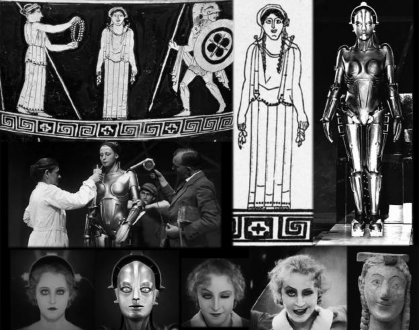
[Fig. 8.10. Interesting coincidences in the ancient and modern portrayals of an evil female robot. Top left, Pandora as a stiff automaton being prepared by the gods for her mission on earth (Niobid Vase, fifth century BC) and the actress being groomed for her role as the robot Maria in the film Metropolis(1927). Right, Pandora and Maria robot. Bottom, the transformation of Maria into a robotic winking and smirking double. Last image, Hope/Elpis with crooked smile, sixth century BC. Photo collage by Michele Angel.]
My Reaction to the Image
My response to looking at Leviathan in the frontispiece are the following thoughts:
- his face is rather expressionless and he looks neither very threatening nor particularly thoughtful or intelligent (perhaps even a bit gormless); what does look very threatening are the images of the weapons in the lower half of the picture, which presumably would be used against the people if they refused to obey him. Furthermore, what is not shown (“the unseen”) are the prisons, torture rooms, and squads of religious police who would have to enforce compliance with the Leviathan’s dictates and eliminate all opposition to his rule.
- I ask myself, how did he get all the little people to line up in such a regimented fashion inside his body, and why are they all looking at him the way they are, with such devotion and unquestioning obedience? Did he abduct them from their homes, places of business, and fields (the picture shows them all nearly empty), and force them. Is this the result of a long propaganda war he has waged to scare the people and to win them over to his side? Or did the people beg him to come and rescue them from the terror and destruction of the civil war and revolution which had been raging for years? It made me think of the film The Invasion of the Body Snatchers (1956) made at the height of the Cold War when the fear of Communism taking over the minds (and the bodies) of ordinary Americans and replacing them with compliant and identical “pod people”. Or, is this Leviathan an early (modern) manifestation of the Borg from Star Trek who “assimilate” other species into their “Collective” against which all “Resistance is futile”.
- I secretly hope that hidden in one of the empty houses in the village there is a secret cell of Leveller agitators and conspirators who are preparing to wage a counter-propaganda war against Leviathan’s rule and are getting ready to print and distribute another of their pamphlets, perhaps entitled “Anti-Leviathan” or “An Arrow against all Leviathans”.
The Frontispieces to his Other Books
*History of the Pelopponesian Wars* (1629): Military Aristocracy vs. Plebeian Democracy
The frontispiece of Leviathan (1651) should be seen as the culmination of Hobbes’ thinking about the nature of political power and the strict limits which needed to be placed on individual liberty which he had been developing over the previous 20 years. Hobbes took a great personal interest in the design of the frontispieces to his books, most notably his translation of Thucydides’ History of the Pelopponesian Wars (1629) and De Cive (1642, 1647).
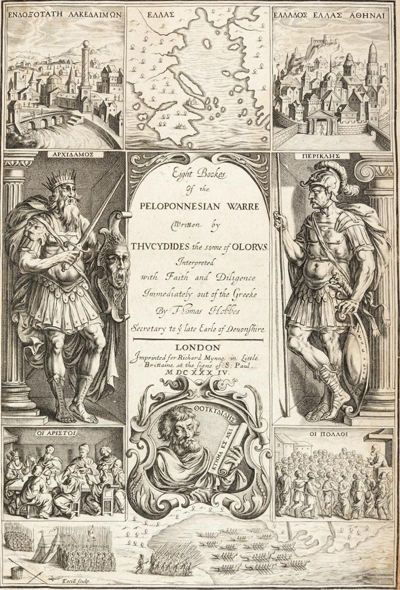
[Thomas Cecill, frontispiece of Thucydides, History of the Peloponnesian War, 1629]
In this frontispiece we see in the centre panels a map of Greece below which is the title of the book and picture of Thucydides. On the left we have a depiction of the city of Sparta below which is a picture of Archidamos, the king of Sparta who is looking to the right making eye to eye contact with his opponent Pericles, and below that is the King being quietly counciled by a group of seated noble advisors (hoi aristoi - the “best”), and then a depiction of formations of Spartan troops. On the right, we have a depiction of the city of Athens; the figure of the leader of its democracy, Pericles looking to the left towards King Archidamos; a scene of Pericles giving a speech to a gathering of citizens (hoi polloi = “the many”), many of whom seem to be poor or lame; and below which is a scene of the Athenian navy approaching the Spartan army. It is clear from this that Hobbes thinks the Athenians are a rabble led or swayed by demagogic leaders while the Spartans are well-ordered and responsibly led by aristocratic, military advisors to a sober king.
*De Cive* (On the Citizen) (1642, 1647): Poverty and a War of all against all under “Liberty” vs. Prosperity and Industry under Power
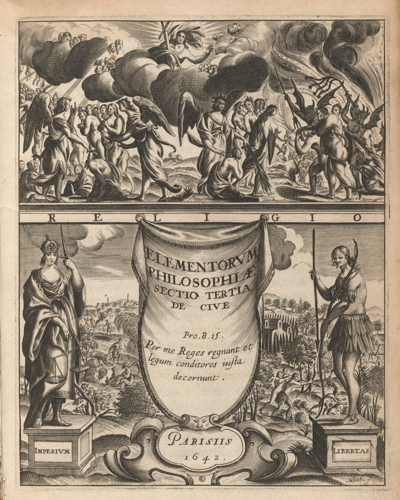
[Jean Matheus and Thomas Hobbes (?), frontispiece of De Cive, 1642]
Compare this with the cruder engraving for the 1647 edition:
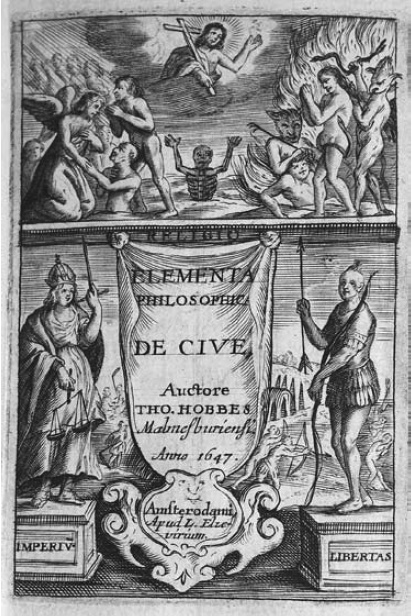
In the frontispiece to De Cive (On the Citizen) there are two panels. The top panel entitled “religio” (religion) shows Christ sitting on a cloud clutching his crucifix, presiding over the final judgement to decide who is redeemed and goes to heaven (on the left) - where we see happy reunions of the “dearly departed” - and who will be punished with “eternal damnation” by going to hell - where we see devils prodding one person with a trident and another being whipped with a cat-o-ninetails.
Below this scene of ultimate reward and punishment we see a curtain in the shape of an amphora which separates the two different types of society which Hobbes believes exist on the earth. On the curtain is written the name of the book, Elementorum Philosophiae Sectio Tertia de Cive (Philosophical Elements Part Three: On the Citizen), and a verse from Proverbs 8:15, “Per me Reges regnant et legum conditores iusta decernunt” (By me kings reign, and princes decree justice). De Cive was meant to be the third part of a trilogy, De Corpore (On the Body) and De Homine (On Man), but was published first.
To the right of the curtain we can see a society where there is “Libertas” (Liberty). A sullen and very unhappy looking Indian is standing on a pedestal and is holding a long bow and a spear. Behind him we can see the kind of society “liberty” produces in Hobbes’ view: some men with bows and arrows and clubs are pursuing some other men; to the right two men have caught someone and are cooking and eating their flesh; behind a heavily fortified town there lurks a wild animal which looks like a lion. This is the state of war against all and complete insecurity for life and property.
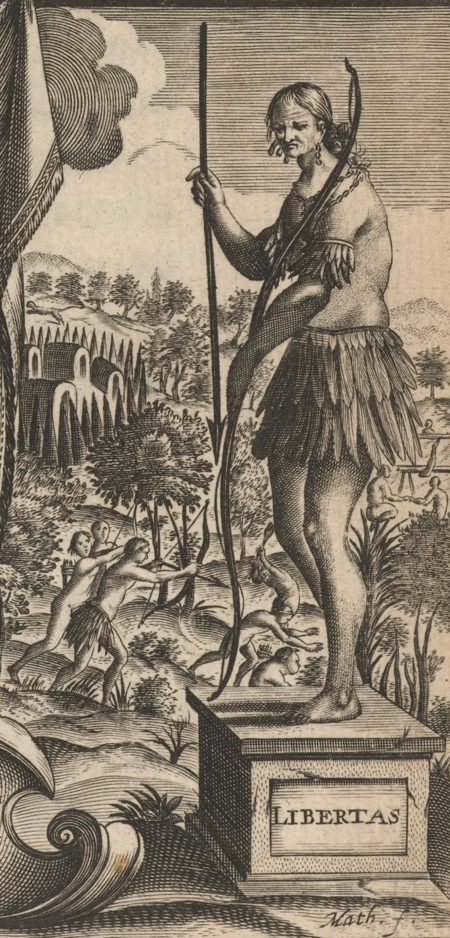
As he put it in Leviathan (Part I: Of Man. CHAP. XIII. Of The Naturall Condition Of Mankind, As Concerning Their Felicity, And Misery.):
Hereby it is manifest, that during the time men live without a common Power to keep them all in awe, they are in that condition which is called Warre; and such a warre, as is of every man, against every man. For Warre, consisteth not in Battell onely, or the act of fighting; but in a tract of time, wherein the Will to contend by Battell is sufficiently known: and therefore the notion of Time, is to be considered in the nature of Warre; as it is in the nature of Weather. For as the nature of Foule weather, lyeth not in a showre or two of rain; but in an inclination thereto of many dayes together; So the nature of War, consisteth not in actuall fighting; but in the known disposition thereto, during all the time there is no assurance to the contrary. All other time is Peace.
Whatsoever therefore is consequent to a time of Warre, where every man is Enemy to every man; the same is consequent to the time, wherein men live without other security, than what their own strength, and their own invention shall furnish them withall. In such condition, there is no place for Industry; because the fruit thereof is uncertain: and consequently no Culture of the Earth; no Navigation, nor use of the commodities that may be imported by Sea; no commodious Building; no Instruments of moving, and removing such things as require much force; no Knowledge of the face of the Earth; no account of Time; no Arts; no Letters; no Society; and which is worst of all, continuall feare, and danger of violent death; And the life of man, solitary, poore, nasty, brutish, and short.
On the left of the curtain stands a women wearing a crown (to show that she has legitimate power) , and holding a sword in one hand (which she points heaven-wards) and the scales of justice in the other. She stands on a pedestal which is named “Imperium” (rule or power). Behind her is depicted the kind of society which the “Power” of Leviathan makes possible: there is a substantial and prosperous looking city on a hill at the rear, men and women work industriously in the fields. This is the state of peace, industry, and law and order.
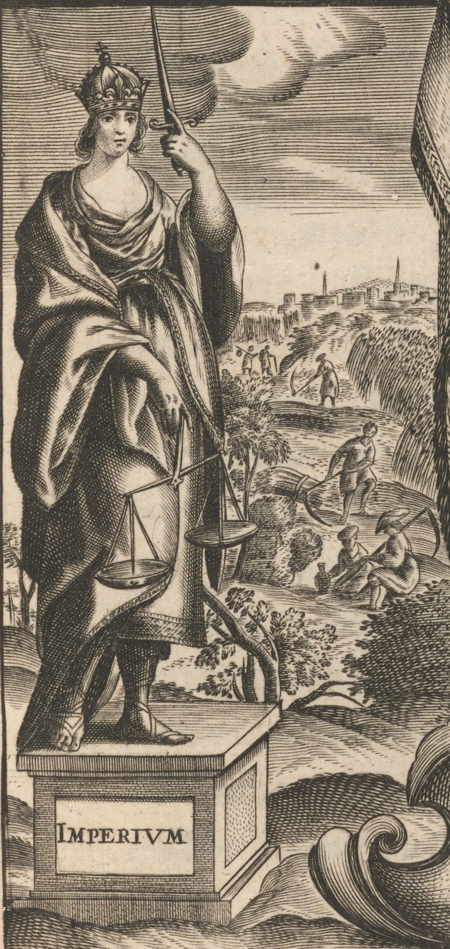
As he put it in Leviathan Part I. Of Man. CHAP. XIII. Of The Naturall Condition Of Mankind, As Concerning Their Felicity, And Misery.:
It may peradventure be thought, there was never such a time, nor condition of warre as this; and I believe it was never generally so, over all the world: but there are many places, where they live so now. For the savage people in many places of America, except the government of small Families, the concord whereof dependeth on naturall lust, have no government at all; and live at this day in that brutish manner, as I said before. Howsoever, it may be perceived what manner of life there would be, where there were no common Power to feare; by the manner of life, which men that have formerly lived under a peacefull government, use to degenerate into, in a civill Warre.
But though there had never been any time, wherein particular men were in a condition of warre one against another; yet in all times, Kings, and Persons of Soveraigne authority, because of their Independency, are in continuall jealousies, and in the state and posture of Gladiators; having their weapons pointing, and their eyes fixed on one another; that is, their Forts, Garrisons, and Guns upon the Frontiers of their Kingdomes; and continuall Spyes upon their neighbours; which is a posture of War. But because they uphold thereby, the Industry of their Subjects; there does not follow from it, that misery, which accompanies the Liberty of particular men.
To this warre of every man against every man, this also is consequent; that nothing can be Unjust. The notions of Right and Wrong, Justice and Injustice have there no place. Where there is no common Power, there is no Law: where no Law, no Injustice. Force, and Fraud, are in warre the two Cardinall vertues. Justice, and Injustice are none of the Faculties neither of the Body, nor Mind. If they were, they might be in a man that were alone in the world, as well as his Senses, and Passions. They are Qualities, that relate to men in Society, not in Solitude. It is consequent also to the same condition, that there be no Propriety, no Dominion, no Mine and Thine distinct; but onely that to be every mans, that he can get; and for so long, as he can keep it. And thus much for the ill condition, which man by meer Nature is actually placed in; though with a possibility to come out of it, consisting partly in the Passions, partly in his Reason.
And again in Part II. CHAP. XXX. Of The Office Of The Soveraign Representative.
The Office of the Soveraign, (be it a Monarch, or an Assembly,) consisteth in the end, for which he was trusted with the Soveraign Power, namely the procuration of the safety of the people ; to which he is obliged by the Law of Nature, and to render an account thereof to God, the Author of that Law, and to none but him. But by Safety here, is not meant a bare Preservation, but also all other Contentments of life, which every man by lawfull Industry, without danger, or hurt to the Common-wealth, shall acquire to himselfe. …
As I have heard some say, that Justice is but a word, without substance; and that whatsoever a man can by force, or art, acquire to himselfe, (not onely in the condition of warre, but also in a Common-wealth,) is his own, which I have already shewed to be false: So there be also that maintain, that there are no grounds, nor Principles of Reason, to sustain those essentiall Rights, which make Soveraignty absolute. For if there were, they would have been found out in some place, or other; whereas we see, there has not hitherto been any Common-wealth, where those Rights have been acknowledged, or challenged. Wherein they argue as ill, as if the Savage people of America, should deny there were any grounds, or Principles of Reason, so to build a house, as to last as long as the materials, because they never yet saw any so well built. Time, and Industry, produce every day new knowledge. And as the art of well building, is derived from Principles of Reason, observed by industrious men, that had long studied the nature of materials, and the divers effects of figure, and proportion, long after mankind began (though poorly) to build: So, long time after men have begun to constitute Common-wealths, imperfect, and apt to relapse into disorder, there may, Principles of Reason be found out, by industrious meditation, to make their constitution (excepting by externall violence) everlasting. And such are those which I have in this discourse set forth: Which whether they come not into the sight of those that have Power to make use of them, or be neglected by them, or not, concerneth my particular interest, at this day, very little. But supposing that these of mine are not such Principles of Reason; yet I am sure they are Principles from Authority of Scripture; as I shall make it appear, when I shall come to speak of the Kingdome of God, (administred by Moses,) over the Jewes, his peculiar people by Covenant.
My response to the frontispiece of De Cive is that Hobbes has things completely backwards, that life under “Imperium” (Power) or total state control of people’s lives and property would be one of poverty, death, and uncertainty about the security of one’s life and property and an absence of all individual liberty. It would also be a society in which a powerful religious and military class would have power over everybody else, and would persecute those who thought and behaved differently in the harshest manner possible. It is clear that Hobbes has no understanding of the most elementary principles of economics and what make a prosperous and productive life possible. These notions were beginning to appear in the 17th century and many Levellers used economic arguments in their criticism of restrictions on trade, monopolies and subsidies to favoured groups, the exclusion of many people from certain jobs and careers (which were reserved for a privileged elite), and high taxes. Perhaps if Hobbes had spent less time reading the bible and more time reading some of the Leveller tracts or the early economic writings described by Joyce Appleby in her pioneering work Economic Thought and Ideology in Seventeenth Century England (1978) he might have spared himself from these terrible errors.
Conclusion
In my view the purpose of images such as those in the frontispieces, especially that of Leviathan, was one of propaganda for the absolutist state, or rather a Christian dictatorship or “Christian Common-Wealth” as he called it, to depict in a visually striking and powerful manner, the size and overwhelming power of the “Common Power”, the “Common-Wealth”, the “State” as he wanted it to become. These images were designed to instill awe and fear in the hearts and minds of ordinary citizens who would never dare from now on to challenge the power of the Leviathan State. They would be “terrified” of this power and what could happen to them if they challenged it or disobeyed its commands:
“For by this Authoritie, given him by every particular man in the Common-Wealth, he hath the use of so much Power and Strength conferred on him, that by terror thereof, he is inabled to forme the wills of them all, to Peace at home, and mutuall ayd against their enemies abroad.”
To most effectively instill this awe and fear, the power of Leviathan had to be “visible”. As Hobbes said in Part II. Of Common-Wealth. Chap. XVII. Of The Causes, Generation, And Definition Of A Common-Wealth.
The finall Cause, End, or Designe of men, (who naturally love Liberty, and Dominion over others,) in the introduction of that restraint upon themselves, (in which wee see them live in Common-wealths,) is the foresight of their own preservation, and of a more contented life thereby; that is to say, of getting themselves out from that miserable condition of Warre, which is necessarily consequent (as hath been shewn) to the naturall Passions of men, when there is no visible Power to keep them in awe, and tye them by feare of punishment to the performance of their Covenants, and observation of those Lawes of Nature set down in the fourteenth and fifteenth Chapters.
Hence, the “visible” frontispieces which were so striking to the eye of the reader, but not of course to the mass of the people who would never open such a book (unless the state published a cheap comic book or graphic novel edition of Leviathan for Dummies). How they were to see the Leviathan and be got in awe of it, is not explained, unless a giant sea-monster did appear out of the ocean and march up the Thames river so everybody could see him/it. More likely of course is that they would be told about the necessity of having a Leviathan state from the pulpit every Sunday from the state sanctioned monopoly church with its tax-payer funded priestly class.
Coda: Sedition as Sicknesse, Civil War as Death, and the State as the Doctor
If we return to the opening passage of the Leviathan where Hobbes laboriously maps out how the various functions of the state correlate with parts of the “Body Politique” or the “Artificial man” there is an interesting reference to “sicknesse.” It should be remembered that Hobbes thought only the Leviathan state could truly look after the “salus populi” which he translates as “the peoples safety” but which can also be translated as “the health of the people”. Below I lay out the correspondences in a way that should be easier to follow:
- the Soveraignty is an Artificiall Soul, as giving life and motion to the whole body;
- The Magistrates, and other Officers of Judicature and Execution, (are the) artificiall Joynts;
- Reward and Punishment (by which fastned to the seate of the Soveraignty, every joynt and member is moved to performe his duty) are the Nerves, that do the same in the Body Naturall;
- The Wealth and Riches of all the particular members, are the Strength;
- Salus Populi (the peoples safety) (is) its Businesse;
- Counsellors, by whom all things needfull for it to know, are suggested unto it, are the Memory;
- Equity and Lawes, (are) an artificiall Reason and Will;
- Concord, (is its) Health;
- Sedition, (its) Sicknesse ;
- and Civill war, (its) Death.
- Lastly, the Pacts and Covenants, by which the parts of this Body Politique were at first made, set together, and united, resemble that Fiat, or the Let us make man, pronounced by God in the Creation.
Some sharp-eyed commentators have noted that there are two figures in the centre of the frontispiece just above and to the right of the curtain which look like two men wearing the distinctive bird-beak shaped mask of a plague doctor:
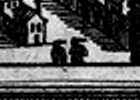
The larger picture below will provide more detail. It is a copper engraving of Doctor Schnabel (i.e., Dr. Beak) who was a plague doctor in seventeenth-century Rome, circa 1656. See also Wikipedia https://en.wikipedia.org/wiki/Plague_doctor.
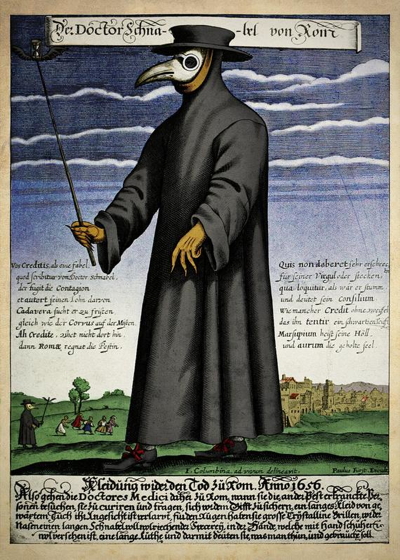
This interpretation might be a bit of a stretch as they could just be wearing a large oddly shaped hat, but it does fit with what Hobbes thought about sedition as a kind of plague of the mind which had to be eliminated in order to protect the body politic. This is what Leviathan has just done in the frontispiece of Leviathan by removing dissent and sedition which was a major cause of civil war. Most of the citizens have been incorporated into his body and made to conform and obey his dictates without question. The two plague doctors might be just sitting back and surveying the handiwork of Leviathan. They might have even helped him to do this. If so, it would not be the only time that doctors have helped the Leviathan state subdue the population so the state could rule without opposition.
Some References
Giorgio Agamben, Stásis: Civil War as a Political Paradigm (Homo Sacer II, 2). Translated by Nicholas Heron (Stanford University Press, 2015).
[Alter] The Hebrew Bible. A Translation with Commentary by Robert Alter (New York: W.W. Norton, 2019). 3 vols.
Joyce Appleby, Economic Thought and Ideology in Seventeenth Century England (Princeton University Press,1978).
[Bekkum] Playing with Leviathan: Interpretation and Reception of Monsters from the Biblical World (Leiden: Brill, 2017). Edited by Koert van Bekkum, Jaap Dekker, Henk R. van den Kamp, and Eric Peels.
- Gert Kwakkel, “ The Monster as a Toy. Leviathan in Psalm 104:26,” pp. 77-89.
- Nicholas Ansell, “Fantastic Beasts and Where to Find The(ir Wisdo)m: Behemoth and Leviathan in the Book of Job,” pp. 90-114.
William Blake, Blake’s Illustrations of the Book of Job. With Descriptive Letterpress, and A Sketch of the Artist’s Life and Works. By Charles Eliot Norton (Boston: James R. Osgood and Co., 1875). https://oll.libertyfund.org/title/norton-blake-s-illustrations-of-the-book-of-job.
Horst Bredekamp, Thomas Hobbes Visuelle Strategien. Der Leviathan: Das Urbild des modernen Staates. Werkillustrationen und Portraits (Berlin, Akademie, 1999). 4th corrected edition 2012.
Horst Bredekamp, “Thomas Hobbes’s Visual Strategies,” in The Cambridge Companion to Hobbes’s Leviathan. Edited by Patricia Springborg (Cambridge University Press, 2007), pp. 29-60. This is an English summary of his longer work Thomas Hobbes Visuelle Strategien. Der Leviathan: Das Urbild des modernen Staates. Werkillustrationen und Portraits (Berlin, Akademie, 1999).
Thomas Hobbes, Historia Ecclesiastica. Critical edition, including text, translation, introduction, commentary and notes, by Patricia Springborg, Patricia Stablein and Paul Wilson (Paris: Honoré Champion Éditeur 2008).
Magnus Kristiansson and Johan Tralau, “Hobbes’s hidden monster: A new interpretation of the frontispiece of Leviathan,” European Journal of Political Theory (2014 13: 299).
Adrienne Mayor, Gods and Robots: Myths, Machines, and Ancient Dreams of Technology (Princeton University Press, 2018).
[Springborg] The Cambridge Companion to Hobbes’s Leviathan. Edited by Patricia Springborg (Cambridge University Press, 2007).
- Horst Bredekamp, “Thomas Hobbes’s Visual Strategies,” pp. 29-60.
- Johan Tralau, “Leviathan, the Beast of Myth: Medusa, Dionysos, and the Riddle of Hobbes’s Sovereign Monster,” pp. 61-81.
"P.K".
- “Map Monsters: Medieval and Renaissance Cartographic Sea Monsters,” Bibliodyssey (Aug. 2013) http://bibliodyssey.blogspot.com/2013_08_25_archive.html;
- “Monstrorum Historia: Woodcut illustrations from Aldrovandi’s History of Monsters” (1642), Bibliodyssey (July 13, 2011) http://bibliodyssey.blogspot.com/2011/07/monstrorum-historia.html.
Patricia Springborg, “Hobbes’s Biblical Beasts: Leviathan and Behemoth” Political Theory (Vol. 23, No. 2 (May, 1995), pp. 353-375.